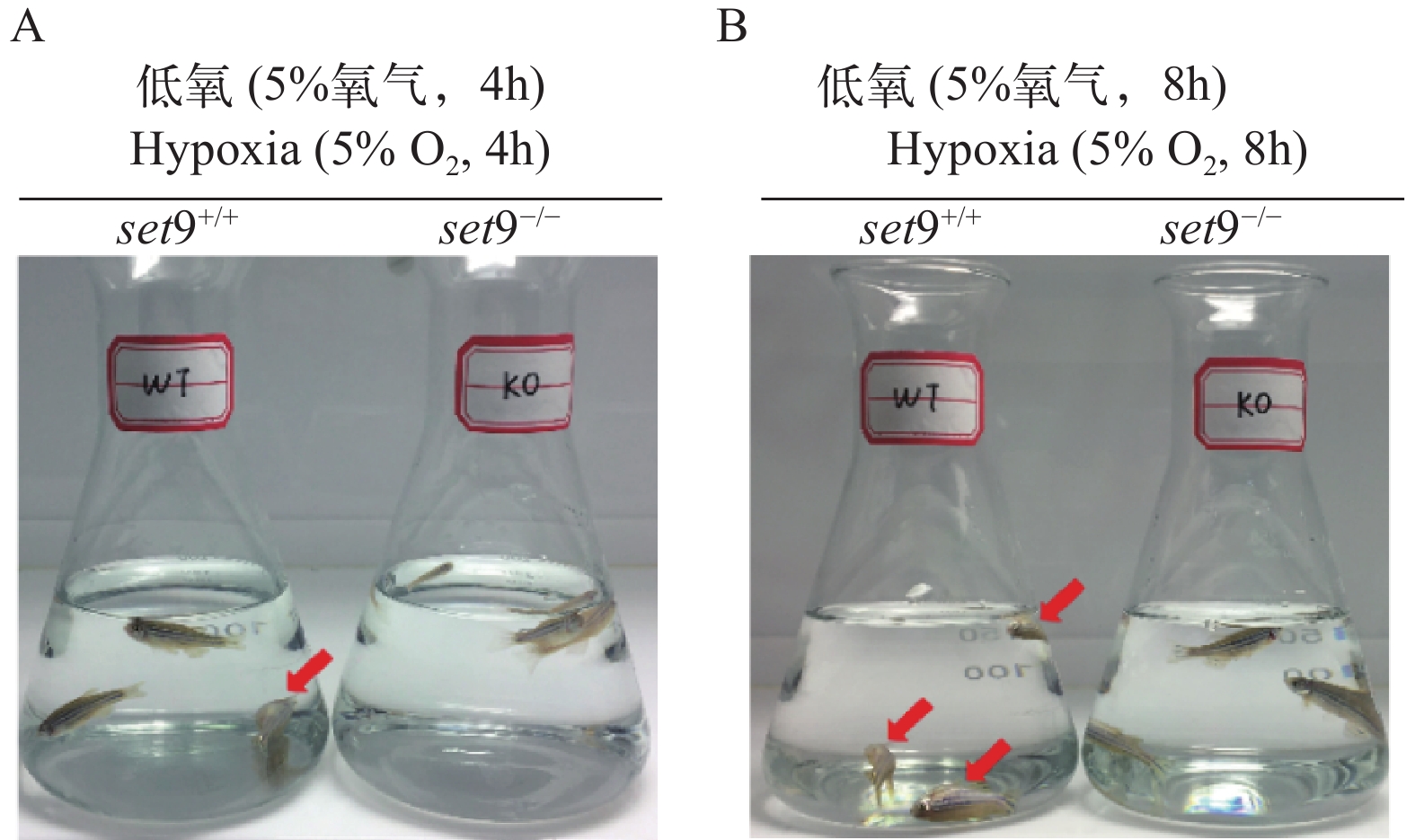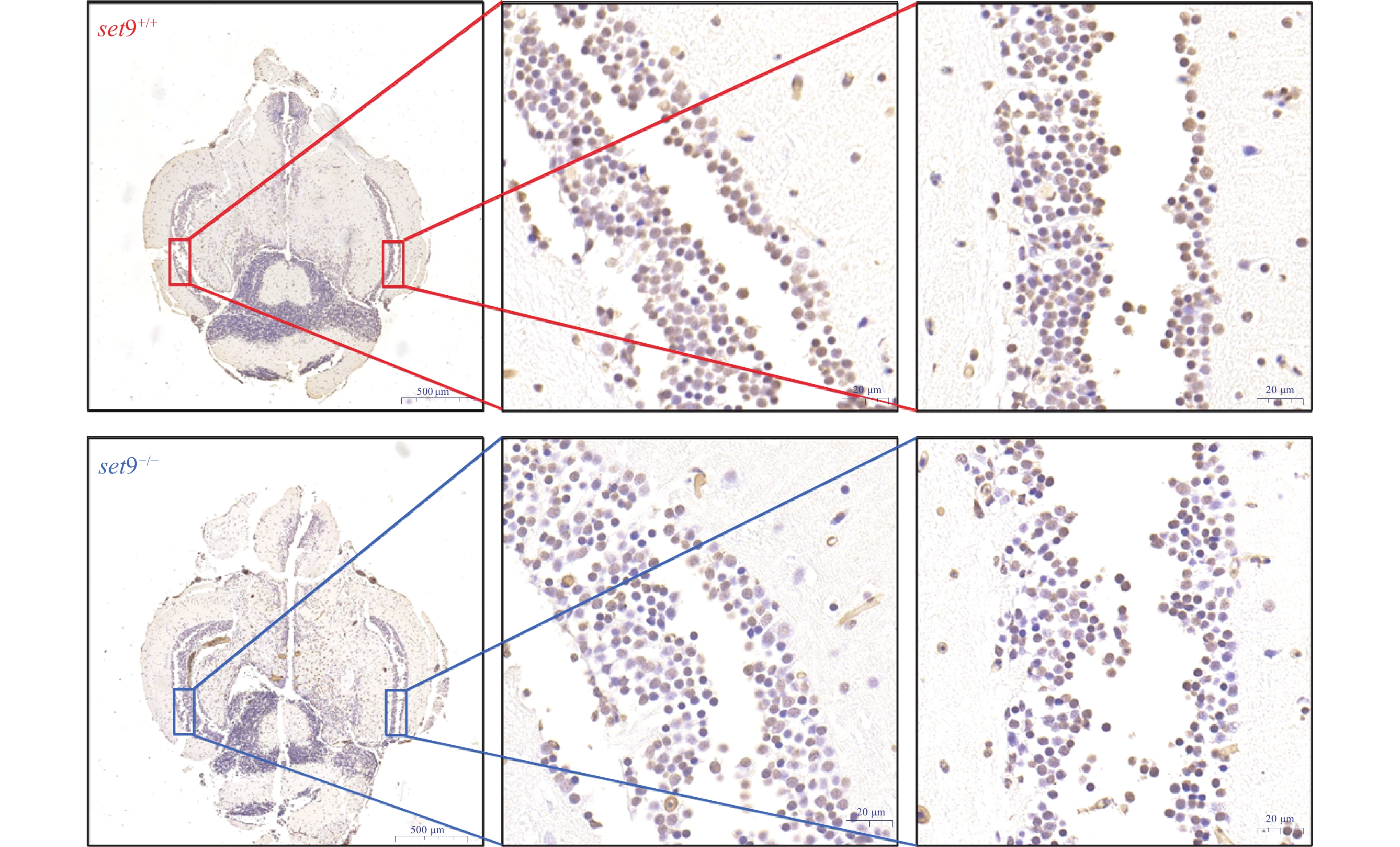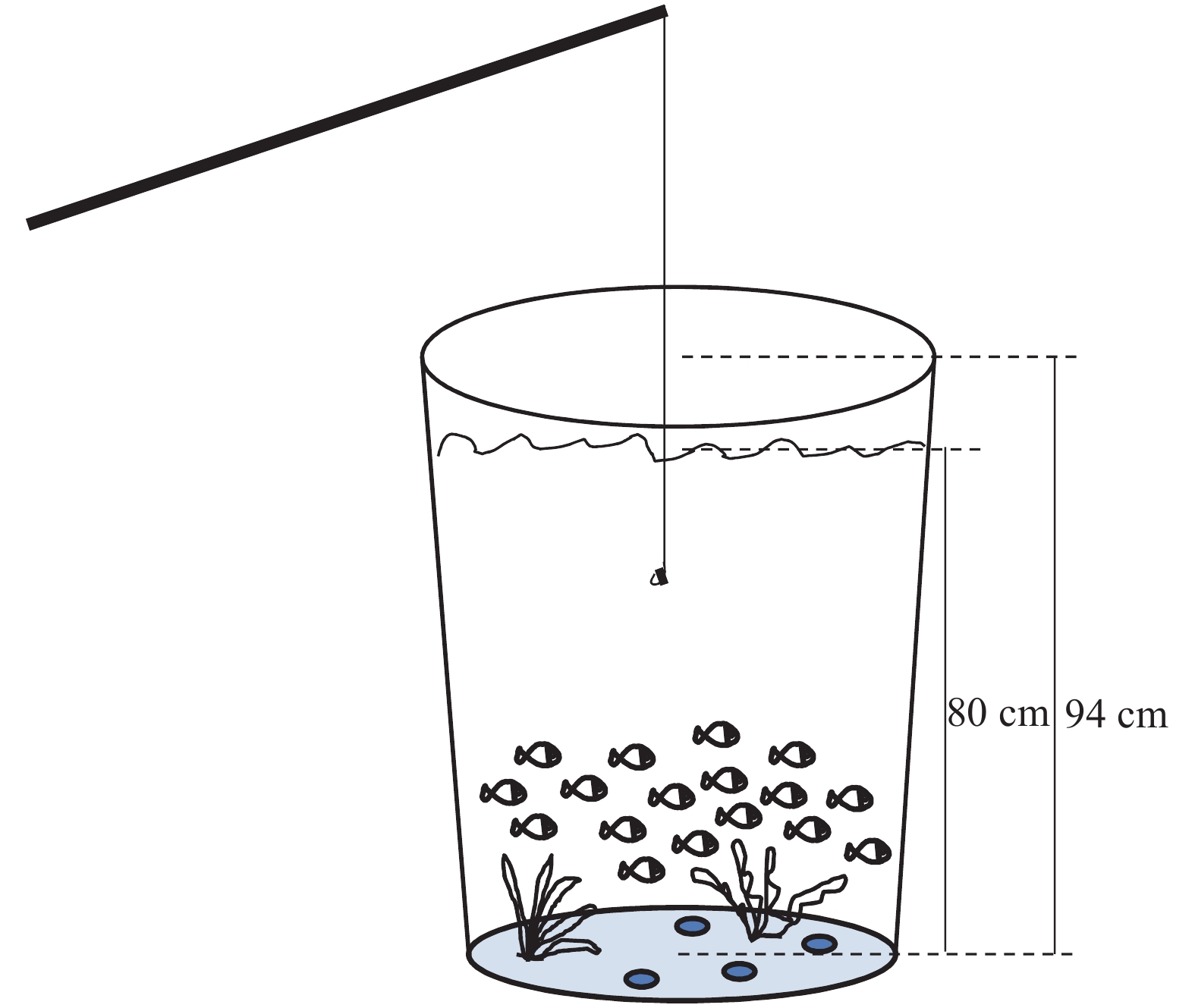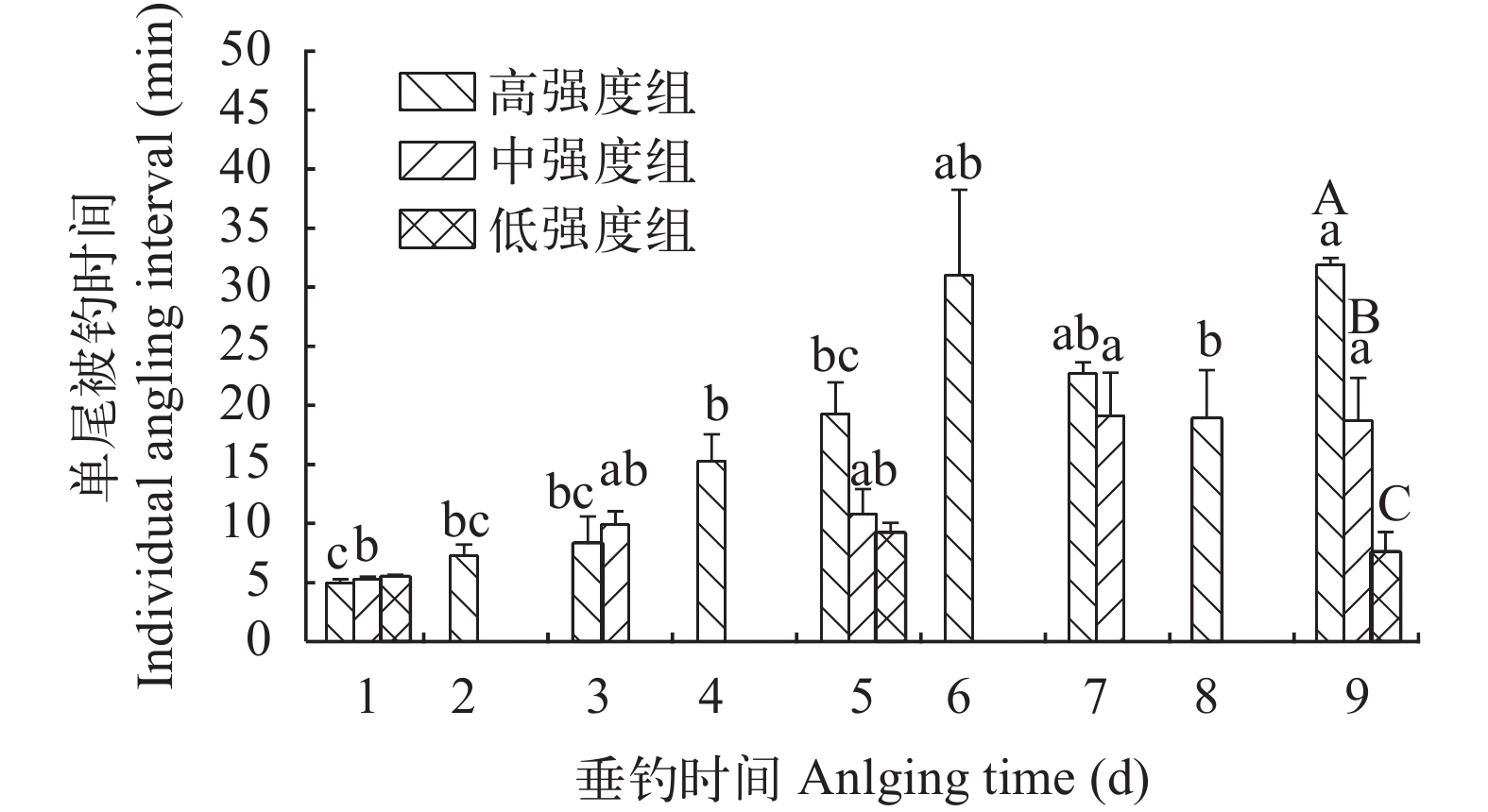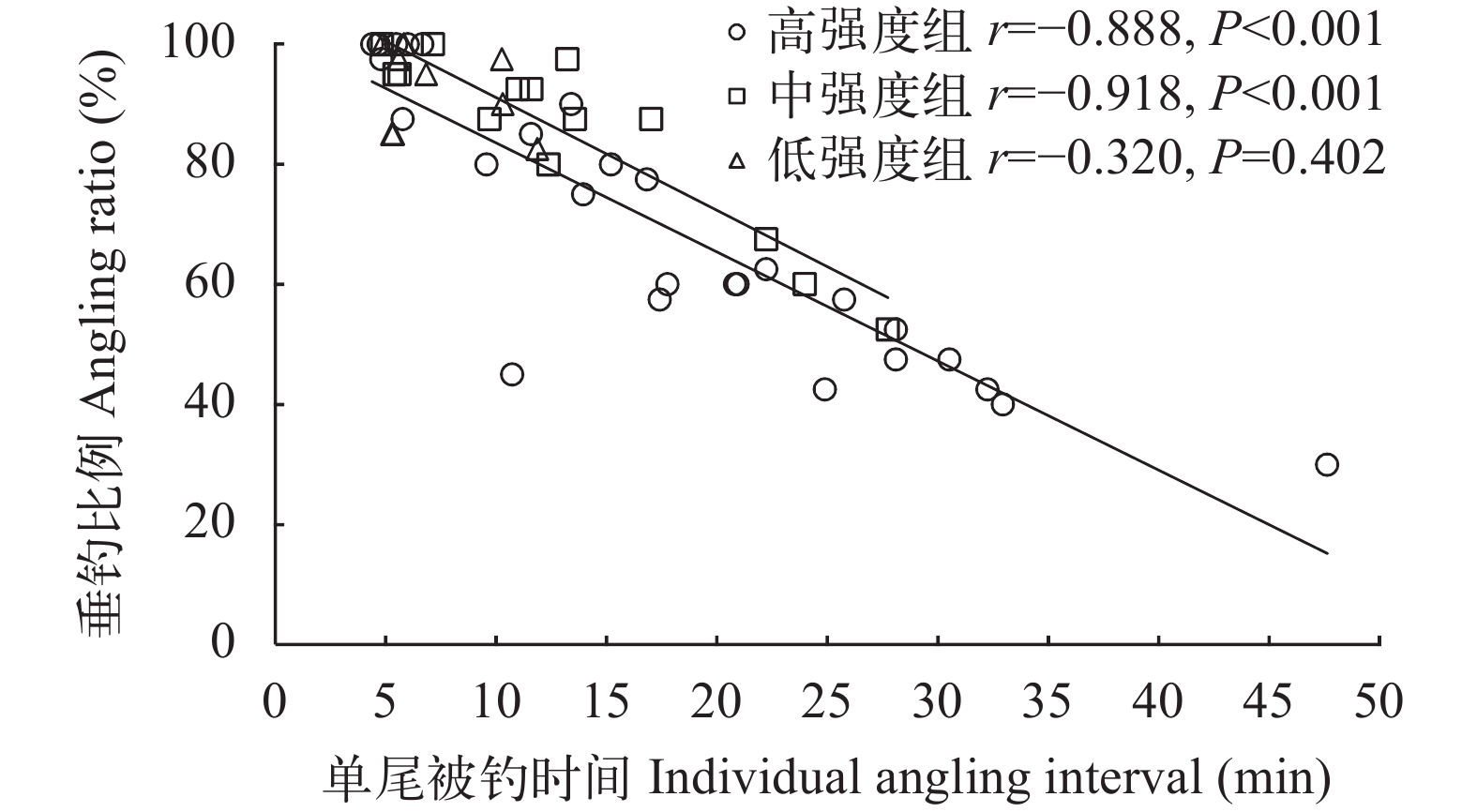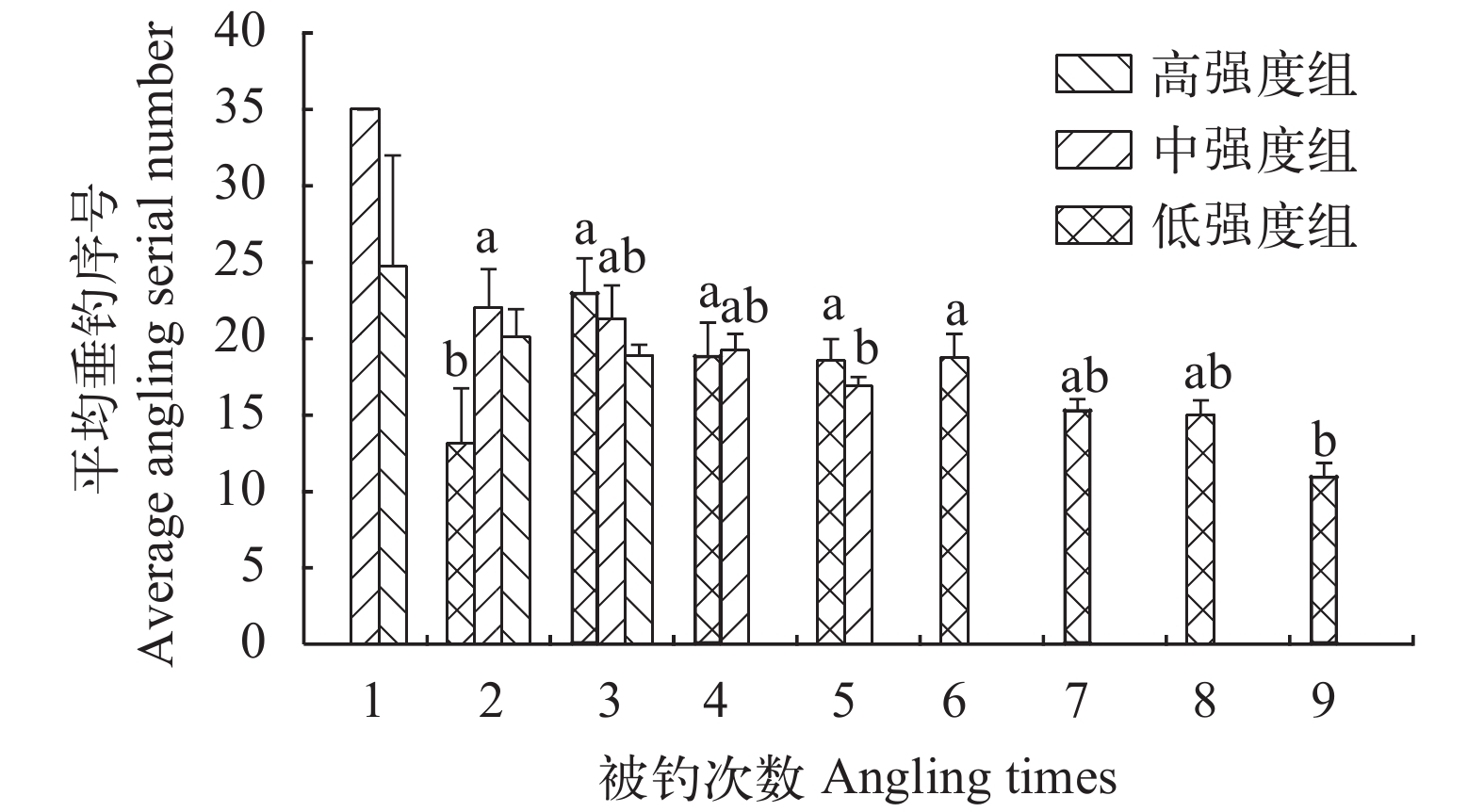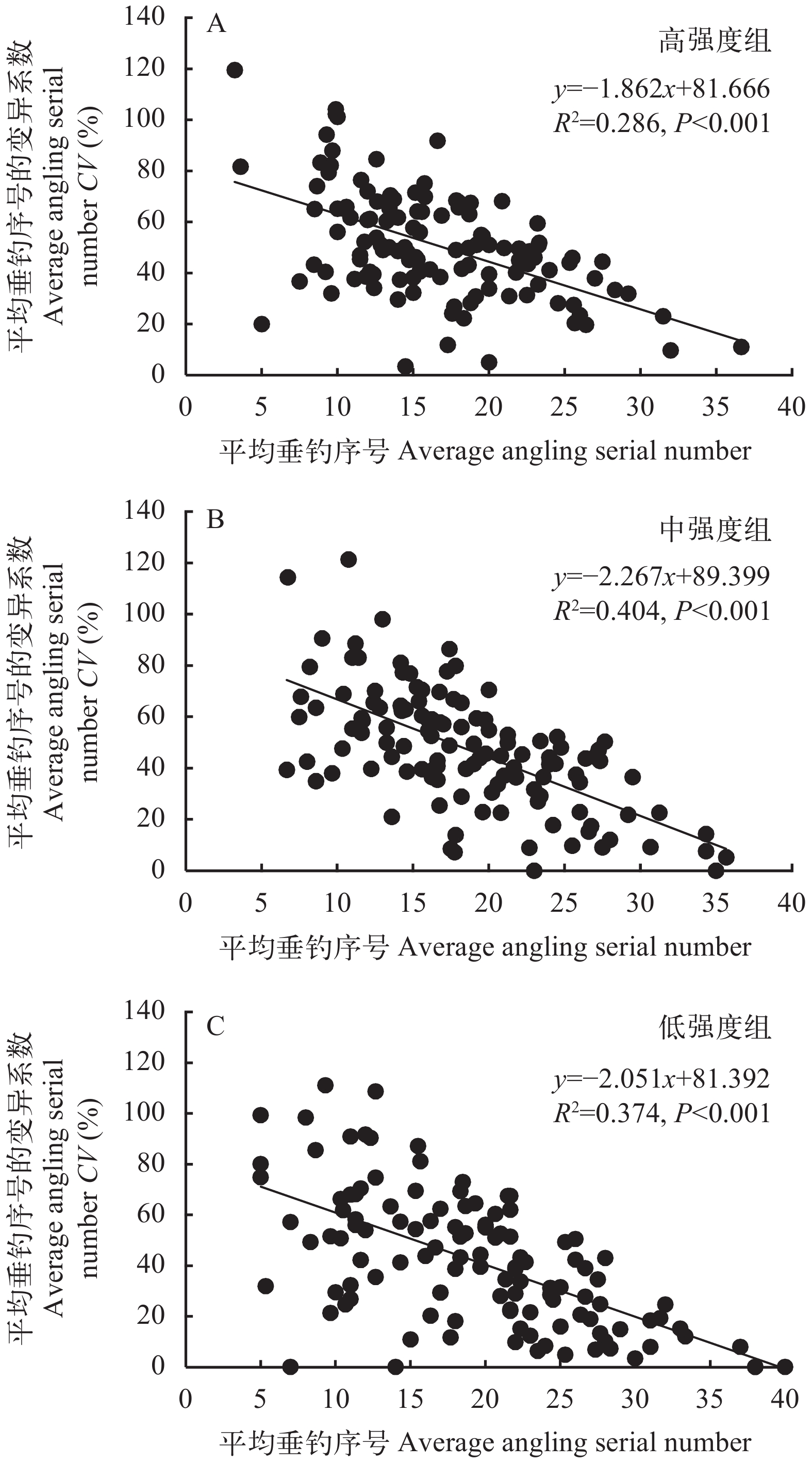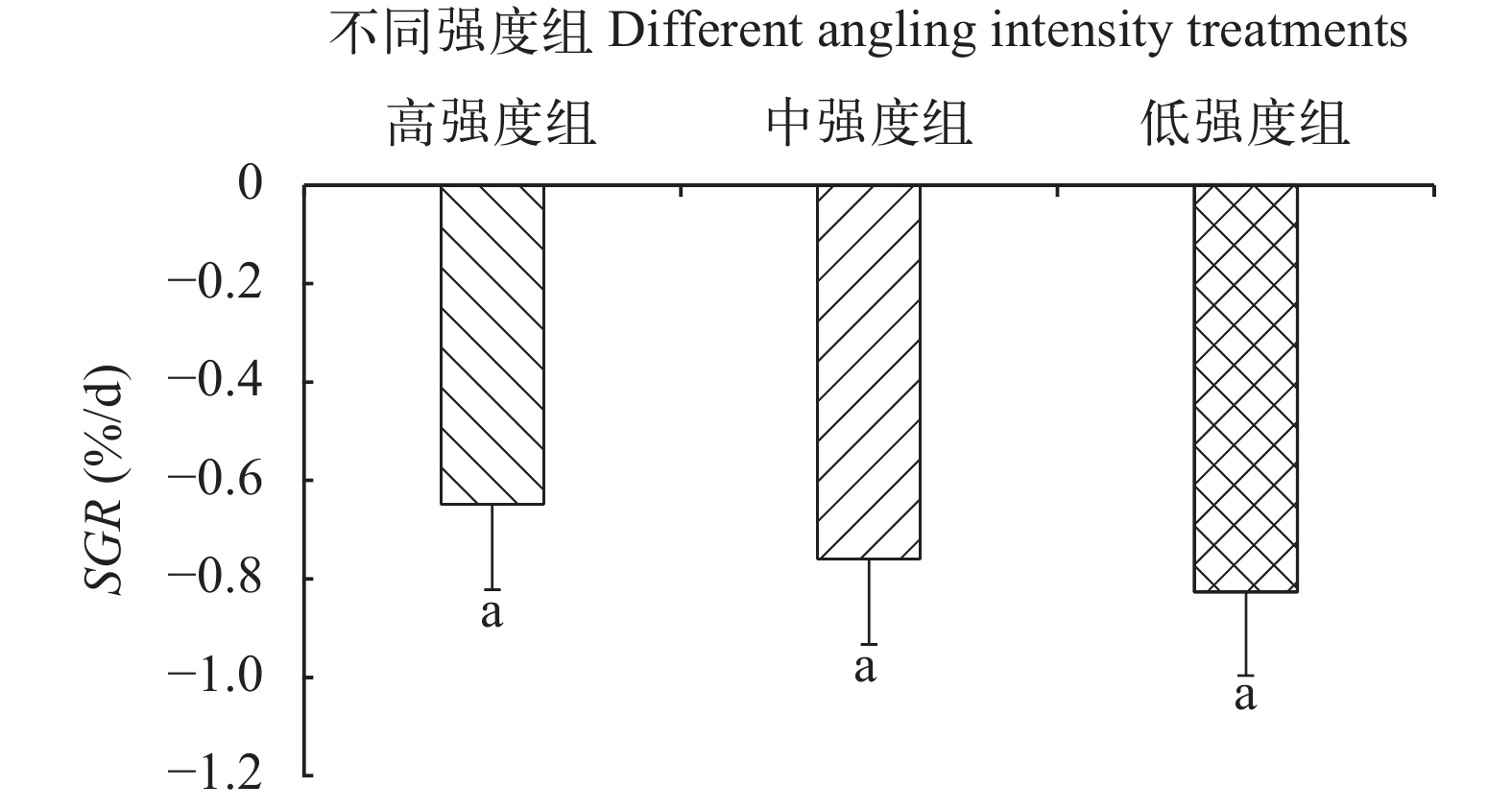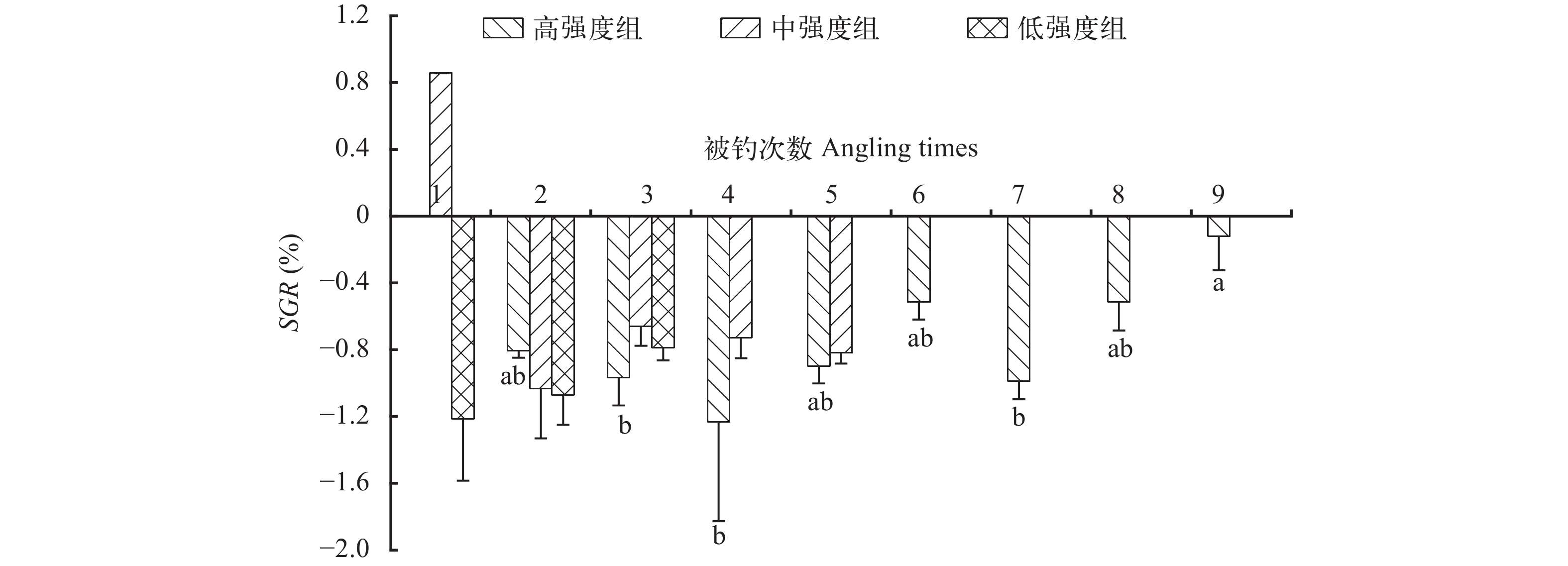EFFECT OF ANGLING INTENSITY ON THE VULNERABILITY TO ANGLING AND GROWTH OF JUVENILE CRUCIAN CARP
-
摘要: 为考察不同垂钓强度对鲤科鱼类易钓性和生长的影响, 研究以鲫(Carassius auratus)幼鱼为实验对象, 在实验(26.9±0.1)℃条件下对大小相近和机体健康的3个处理组[高强度组(1d垂钓1次)、中强度组(2d垂钓1次)和低强度组(4d垂钓1次)]进行垂钓实验; 每个垂钓处理组均设3个平行组, 每个平行组包括40尾鱼, 每个组在垂钓10h后则停止该组的垂钓活动, 记录成功垂钓每尾鱼的时间、序号和电子标签信息, 计算垂钓比例、单尾被钓时间、平均垂钓序号、变异系数和实验期间(9d)的生长率。研究发现: 3个垂钓强度组的垂钓比例均随着垂钓次数的增加而呈现下降的变化趋势, 单尾被钓时间呈现增加的变化趋势, 导致垂钓比例与单尾被钓时间呈负相关。除低强度组外, 高、中垂钓强度组的平均垂钓序号随着被钓次数的增加均呈现减小的变化趋势, 并且该2个强度组平均垂钓序号的变异系数随着被钓次数的增多均呈增大的变化趋势; 3个垂钓强度组的平均垂钓序号与其变异系数呈负相关。3个垂钓强度组在实验期间的特定生长率均出现负值情况, 但3个组之间无差异。研究表明: 高强度的垂钓活动会降低鲫幼鱼的易钓性, 并且导致个体生长表现出一定的负面效应, 表明高强度垂钓活动可能影响鱼类野外种群易钓性及其相关的其他表型的进化轨迹。Abstract: The vulnerability to angling refers to the stable difference in the probability of being caught among individuals within a fish species, which is easy to be affected by various environmental factors. Fish in nature are affected by human angling activities, but the characteristics of the effects of different angling intensities on the vulnerability to angling and growth of the Cyprinidae fishes are not clear. In order to investigate the effects of different angling intensities on the vulnerability to angling and growth performance of the Cyprinidae fishes in the Yangtze River, the juvenile crucian carp (Carassius auratus) was used as the experimental object in this study under the condition of the laboratory (26.9±0.1)℃, angling with different intensities for three treatment groups that have similar size and physical fitness, three treatment groups [high frequency group (angling once a day), medium frequency group (angling once every two days) and low frequency group (angling once every four days)]; three parallel groups were set up in each angling treatment group, including 40 fishes in each parallel group. After 10 hours of angling in each repetition, the angling activities of the group were stopped. The angling time, angling serial number and electronic information of each fish successfully fished were recorded. The angling ratio, individual fish angling interval, average angling serial number and its coefficient variation as well as the specific growth rate of fish during the experimental period (9d) were all calculated. The results showed that the angling proportion of the three angling intensity groups decreased with the increase of angling times, and the individual angling interval showed an increasing trend with angling time increased, which results in a negative correlation between angling proportion and individual angling interval. Except for the low intensity treatment, the average angling serial number of both the high and medium angling intensity treatments showed a decreasing trend with the increase of the angling times, and the coefficient variation of the average angling serial number of the two intensity treatments increased with the increase of the angling times. The average angling serial number of the three treatment treatments was negatively correlated with its variation coefficient. The specific growth rates of the three angling intensity treatments were all negative during the experiment, but there was no significant difference among the three groups. Our results suggested that high intensity angling activities can reduce vulnerability to angling of the juvenile crucian carp, and it can lead to obvious negative angling effect of individual growth, which shows that high-intensity fishing activities may affect vulnerability to angling and evolutionary trajectory of other related phenotypes of the wild fish populations.
-
低氧诱导因子(Hypoxia inducible factor, HIF)介导的转录激活调控是细胞感受氧气变化和应答低氧胁迫的最为关键的信号传导途径[1, 2]。低氧信号传导途径非常保守, 从线虫到人类, 低氧信号都启动相同或相似的同源基因的转录和调控, 从而调控类似的生理和生化反应[3]。HIF由HIF-α(包括HIF-1α和HIF-2α)和HIF-1β两个亚单位组成, 每个亚单位都包含基本的bHLH-PAS (helix-loop-helix-PAS)结构域, 该结构域介导异源二聚体的形成及与DNA的结合。HIF-1β的蛋白水平稳定, 因而HIF的活性主要由HIF-α来决定[4, 5]。在常氧条件下, HIF-α能够被一类依赖于氧气的脯氨酸羟化酶(Prolyl hydroxylase domain enzymes, PHDs, 包括PHD1, PHD2 和PHD3)所识别, 进而对HIF-α(包括HIF-1α和HIF-2α)上特定的脯氨酸残基进行羟基化修饰, 其中, PHD2是起主要作用的脯氨酸羟化酶[6]。被羟基化修饰的HIF-α能被pVHL(Von Hippel-Lindau)识别, pVHL能够与ElonginB、ElonginC结合形成E3泛素连接酶复合体, 介导HIF-α通过蛋白酶体降解[7]。在低氧条件下, 由于氧气的缺乏, 使得脯氨酸羟化酶的活性受到抑制, HIF-α的羟基化修饰受到抑制, 进而导致HIF-α的蛋白酶体降解途径受到抑制, 从而导致HIF-α的蛋白水平得以积累, 积累的HIF-α进入细胞核, 与HIF-1β形成异源二聚体, 该二聚体与下游基因启动子上的低氧应答元件(Hypoxia response element, HRE)结合, 从而激活下游基因的表达, 发挥相应的生物学功能[1, 4]。
蛋白质赖氨酸残基上的甲基化修饰主要是由一类含有SET 保守结构域的蛋白质完成的, 目前在哺乳动物中已鉴定到50多种蛋白质可以归入这一家族, 组蛋白甲基转移酶SET9就是该家族的成员[8, 9]。SET9可以甲基化修饰组蛋白H3上第4位的赖氨酸残基, 也可以对多种非组蛋白进行甲基化修饰[10-12]。SET9可以甲基化修饰p53上第372位的赖氨酸残基, 从而激活p53的转录活性[13]。SET9可以甲基化RelA第37位的赖氨酸残基, 在肿瘤坏死因子TNFα的刺激下增强RelA与下游基因启动子的结合[14]; SET9也可以甲基化RelA第314和315位的赖氨酸残基, 从而促进与下游基因启动子结合的RelA的降解, 抑制NF-κB信号通路的激活[15]。
前期的研究工作发现SET9可以甲基化HIF-1α上第32位的赖氨酸残基, 抑制HIF-1α与下游基因启动子的结合, 从而抑制低氧信号通路下游基因的表达[16]。但是, SET9在体内调控低氧信号通路和在低氧胁迫中的生物学功能及其机制还并不清楚。
研究基因在体生物学功能最好的手段是建立该基因敲除的动物模型。斑马鱼(Danio rerio)是重要的模式生物, 建立目的基因敲除的斑马鱼品系有助于研究该基因的在体生物学功能。前期的研究工作以斑马鱼为模式生物, 建立了foxo3b、tet1及fih敲除的斑马鱼品系, 用以研究这些基因在低氧耐受中的生物学功能。foxo3b可以诱导vhl的表达, 从而促进hif-α的降解, foxo3b的敲除会导致斑马鱼低氧耐受能力的下降[17]; tet1可以稳定hif-α的蛋白水平, tet1的敲除会降低斑马鱼的低氧耐受能力[18]; fih可以抑制hif-α的转录激活活性, fih的敲除可以增强斑马鱼的低氧耐受能力[19]。
本研究利用CRISPR/Cas9基因编辑技术, 获得了甲基转移酶set9敲除的斑马鱼品系, 初步分析了set9基因的敲除对斑马鱼低氧耐受能力的影响, 为研究鱼类甲基转移酶set9在低氧耐受中的生物学功能及耐低氧鱼类新品种的培育提供了理论依据。
1. 材料与方法
1.1 主要试剂及仪器
主要试剂 DNA胶回收试剂盒购自Bioflux公司, 质粒小提试剂盒购自天根公司, 限制性内切酶、RNAiso plus购自TaKaRa, All-in-One cDNA Synthesis SuperMix kit试剂盒、SYBR Green Fast quantitative PCR master mix试剂盒购自Biotool公司, T4 DNA连接酶、DNase Ⅰ购自Fermentas公司, T7体外转录试剂盒购自Ambion公司, Agarose、2×Sosoo Mix重组酶购自Tsingke公司, DNA Marker、Trans10感受态细胞购自TransGen公司, 多聚甲醛、DEPC购自Amresco公司。
主要仪器 显微注射仪PLI-100(Harvard Aparatus), 斑马鱼生化培养箱SHP-150(上海精宏), 低氧工作站Invivo2(Ruskinn), 凝胶成像系统(上海培清科技有限公司), 离心机5702、5430、5425D、5415R(Eppendorf), 荧光定量PCR仪Step One Real-Time PCR System(ABI), 恒温水浴锅(上海精宏), Nanodrop 2000浓度定量仪(Thermo), –80℃超低温冰箱(Thermo)。
1.2 斑马鱼品系
AB品系的斑马鱼购自国家斑马鱼资源中心。
1.3 序列分析
使用ClustalX2软件对人SET9、小鼠Set9和斑马鱼set9的氨基酸序列进行比对, 并根据已知的人SET9的结构域标注3个物种的SET结构域及其甲基转移酶的酶活性位点。
1.4 斑马鱼set9基因的敲除与鉴定
利用在线设计工具 (http://crispr.mit.edu) 设计Cas9作用的靶位点; 将体外合成的Cas9 mRNA和gRNA(guide RNA)按照400 ng/μL﹕60 ng/μL混合后, 注射到一细胞期胚胎动物极; 24h后, 利用异双链迁移率测定法(Heteroduplex mobility assay, HMA)筛选有敲除效果的F0代嵌合体; F0代性成熟后与AB品系斑马鱼交配, 筛选到能稳定遗传的F1代杂合子; F1代性成熟后自交可获得对应的野生型和纯合子突变体, 利用PCR扩增基因组中包含Cas9作用靶位点的DNA片段, 经测序确定突变的碱基信息。
1.5 实时荧光定量PCR(qRT-PCR)
取受精后3d的野生型及set9基因敲除的斑马鱼幼鱼, 使用TaKaRa公司的RNAiso plus进行RNA的提取, 使用Biotool公司的All-in-One cDNA Synthesis SuperMix kit试剂盒进行cDNA的合成, 使用Biotool公司的SYBR Green Fast quantitative PCR master mix试剂盒进行qRT-PCR检测, 使用5′-GCATGTGCTGGGTCTACTATC-3′和5′-GGCCATCAGGGTACACATAAG-3′扩增set9的mRNA, β-actin作为内参, 其扩展引物为5′-TACAATGAGCTCCGTGTTGC-3′和5′-ACATACAATGGCAGGGGTGTT-3′。
1.6 斑马鱼低氧处理
使用Ruskinn Invivo2 I-400低氧工作站进行斑马鱼的低氧胁迫处理。对于受精后3d的斑马鱼幼鱼, 低氧胁迫时氧气浓度调整到2%, 将出膜且发育程度一致的野生型及基因敲除的斑马鱼置于6 cm培养皿中, 每皿50条, 加入5 mL的胚胎培养液(Egg water), 放置于低氧工作站中, 每12h统计1次鱼的存活情况, 利用GraphPad 7.0绘制存活曲线; 对于3月龄的斑马鱼成鱼, 低氧胁迫时氧气浓度调整到5%, 将个体大小相近(个体重量±0.02 g)的野生型及基因敲除的斑马鱼放置于250 mL锥形瓶中, 加入200 mL的曝气水, 放置于低氧工作站中, 并进行跟踪拍照, 记录鱼的运动及存活情况。
1.7 TUNEL染色
将个体大小相近(个体重量±0.02 g)的3月龄野生型及基因敲除的斑马鱼放置于低氧工作站, 并在低氧胁迫6h后将对应的野生型及敲除品系的斑马鱼进行脑部的取材和固定, 利用TUNEL染色试剂盒进行染色并进行拍照, 比较斑马鱼脑部细胞凋亡的情况。
1.8 统计学处理
所有相关实验至少重复3次。使用GraphPad 7.0软件展示统计的数据, 结果表示为平均值±SEM。对于所有比对, P<0.05被视为具有统计学意义。
2. 结果
2.1 斑马鱼甲基转移酶set9的序列特征
斑马鱼set9基因的全长CDS长度为1977 bp, 编码373个氨基酸组成的蛋白质。利用ClustalX2软件对人SET9、小鼠Set9和斑马鱼set9的氨基酸序列进行比对, 发现序列的保守性很高。作为一个含SET结构域的赖氨酸甲基转移酶, 斑马鱼set9也含有一个保守的SET结构域(图 1中虚线框标注)并且其发挥甲基转移酶活性的酶活性位点在三个物种间都是保守的(图 1中实线框标注)。
2.2 建立set9基因敲除的斑马鱼品系
根据CRISPR/Cas9基因编辑技术的原理, 在斑马鱼set9基因的第一个外显子上, 设计了基因编辑的靶位点, 其序列为5′-GGACAGCGATGATGACAACA-3′(图 2A)。提取基因编辑品系鱼尾基因组, 使用引物5′-AGTGCAGGGCTGATGATG-3′和引物5′-CTAATCCTCGACGGAATGAGAC-3′扩增包含靶位点的DNA片段, 经异双链迁移率测定法筛选获得有效果的F0代(图 2B)。
![]() 图 2 利用CRISPR/Cas9技术敲除斑马鱼set9基因A. 斑马鱼set9基因结构及敲除靶位点示意图; B. 异源双链迁移实验检测突变体敲除效果; C. RT-PCR检测野生型及敲除品系的斑马鱼中set9的mRNA水平Figure 2. Targeting strategy for generating zebrafish set9 mutant by CRISPR/Cas9A. Schematic of targeting site in set9 and the resulted nucleotide sequence in the mutant; B. Verification of the efficiency of CRISPR/Cas9-mediated zebrafish set9 disruption by HMA (heteroduplex mobility assay). Genomic DNA was prepared from the pools of injected embryos. The injected (Cas9 mRNA & gRNA) pools contain heteroduplex band, indicating that the site has been disrupted; C. The relative mRNA levels of set9 in the wild-type (WT) (set9+/+) or homozygous mutant (set9−/−) (3 dpf) detected by quantitative real-time PCR (qRT-PCR)
图 2 利用CRISPR/Cas9技术敲除斑马鱼set9基因A. 斑马鱼set9基因结构及敲除靶位点示意图; B. 异源双链迁移实验检测突变体敲除效果; C. RT-PCR检测野生型及敲除品系的斑马鱼中set9的mRNA水平Figure 2. Targeting strategy for generating zebrafish set9 mutant by CRISPR/Cas9A. Schematic of targeting site in set9 and the resulted nucleotide sequence in the mutant; B. Verification of the efficiency of CRISPR/Cas9-mediated zebrafish set9 disruption by HMA (heteroduplex mobility assay). Genomic DNA was prepared from the pools of injected embryos. The injected (Cas9 mRNA & gRNA) pools contain heteroduplex band, indicating that the site has been disrupted; C. The relative mRNA levels of set9 in the wild-type (WT) (set9+/+) or homozygous mutant (set9−/−) (3 dpf) detected by quantitative real-time PCR (qRT-PCR)F0发育至性成熟后与AB品系交配, 筛选到能稳定遗传的F1代, 获得一个缺失8个碱基的品系。由于在翻译起始密码子之后, 缺失8个碱基, 造成移码突变, 终止密码子提前出现, 使得突变的品系只表达不包含SET结构域的14个氨基酸的多肽(图 2A)。由于翻译的提前终止, 会导致mRNA的不稳定性, 进而导致mRNA的快速降解, 因此, 进一步利用qRT-PCR技术分析野生型和突变品系中set9的mRNA水平, 结果显示突变品系中set9的mRNA水平显著下降(图 2C)。
以上结果表明, 利用CRISPR/Cas9基因编辑技术, 获得了set9基因敲除的斑马鱼品系。在实验室正常饲养条件下, set9基因敲除的斑马鱼与其同胞野生型相比, 发育、生长和繁殖等并无肉眼可见的差异。
2.3 set9的敲除能增强斑马鱼低氧耐受能力
利用获得的set9基因敲除的斑马鱼品系, 分析set9基因在斑马鱼低氧耐受中的功能。首先, 选取出生后3d的斑马鱼幼鱼进行低氧处理。该时期的斑马鱼幼鱼刚孵化出膜, 可以方便地获取足够数量的样本, 且个体差异较小, 因而可以很好地评估斑马鱼低氧耐受能力的差异。将野生型及set9基因敲除的斑马鱼幼鱼放置于氧气含量为2%的低氧工作站中, 随着时间的推移, 记录斑马鱼幼鱼的存活时间, 制作存活曲线。结果显示, 在低氧胁迫处理24h后, 野生型的斑马鱼已经开始死亡, 而set9基因敲除的斑马鱼在处理36h后才出现明显的死亡; 在低氧胁迫处理60h后, 野生型的斑马鱼均已死亡, 而set9敲除的斑马鱼还有部分存活(图 3)。由此可见, set9基因的敲除可以增强斑马鱼幼鱼的低氧耐受能力。
进一步, 选取3月龄的斑马鱼成鱼进行低氧耐受能力的比较。将野生型及set9基因敲除的斑马鱼成鱼放置于氧气含量为5%的低氧工作站中, 录制视频记录斑马鱼的存活及运动的情况。结果显示, 在低氧胁迫处理4h后, 野生型的斑马鱼即开始出现死亡; 在低氧胁迫处理8h后, 野生型的斑马鱼均已死亡, 而set9敲除的斑马鱼则刚开始有鱼出现濒死的迹象(图 4)。以上结果显示, set9基因的敲除可以增强斑马鱼成鱼的低氧耐受能力。
![]() 图 4 set9基因的敲除能增强斑马鱼成鱼的低氧耐受能力野生型以及set9敲除的斑马鱼成鱼(3月龄)放置于氧气含量为5%的低氧工作站中(每组3条, 重复3次), 记录斑马鱼幼鱼的低氧耐受情况。A. 低氧处理4h后的情况, B. 低氧处理8h后的情况。箭头标注的是濒死的斑马鱼Figure 4. Deletion of set9 enhances hypoxia tolerance in zebrafish larvaeThe survival of WT (set9+/+; left flask) and set9-null (set9−/−; right flask) adult zebrafish (3 mpf) after 4h (A) and 8h (B) in hypoxia conditions (5% O2). Arrows, dying zebrafish
图 4 set9基因的敲除能增强斑马鱼成鱼的低氧耐受能力野生型以及set9敲除的斑马鱼成鱼(3月龄)放置于氧气含量为5%的低氧工作站中(每组3条, 重复3次), 记录斑马鱼幼鱼的低氧耐受情况。A. 低氧处理4h后的情况, B. 低氧处理8h后的情况。箭头标注的是濒死的斑马鱼Figure 4. Deletion of set9 enhances hypoxia tolerance in zebrafish larvaeThe survival of WT (set9+/+; left flask) and set9-null (set9−/−; right flask) adult zebrafish (3 mpf) after 4h (A) and 8h (B) in hypoxia conditions (5% O2). Arrows, dying zebrafish2.4 set9的敲除减轻低氧导致的脑细胞凋亡
为阐明set9敲除的斑马鱼高低氧耐受力的机制, 利用TUNEL染色检测低氧胁迫处理后野生型及set9敲除的斑马鱼脑中细胞凋亡的情况。5% O2处理6h后, 选择存活的野生型及set9敲除的斑马鱼, 对其脑组织取材、固定、切片并进行TUNEL染色。结果表明, 野生型斑马鱼脑中凋亡细胞数量明显高于突变体(图 5)。
![]() 图 5 set9基因的敲除能减少低氧胁迫下的斑马鱼脑部的细胞凋亡野生型及set9敲除的斑马鱼成鱼(3月龄)放置于氧气含量为5%的低氧工作站中, 在低氧处理6h后, 对斑马鱼的脑组织进行取材和固定, 随后进行TUNEL染色。图中褐色的是凋亡的细胞, 而淡蓝色的是正常的细胞Figure 5. Deletion of set9 diminishes hypoxia-induced apoptosis in adult zebrafish brainsTUNEL stain of the brains of WT (set9+/+) and set9-null (set9−/−) adult zebrafish (3 mpf) after exposure to hypoxia (5% O2) for 6h. Apoptotic cells are colored brown; healthy cells are colored baby blue
图 5 set9基因的敲除能减少低氧胁迫下的斑马鱼脑部的细胞凋亡野生型及set9敲除的斑马鱼成鱼(3月龄)放置于氧气含量为5%的低氧工作站中, 在低氧处理6h后, 对斑马鱼的脑组织进行取材和固定, 随后进行TUNEL染色。图中褐色的是凋亡的细胞, 而淡蓝色的是正常的细胞Figure 5. Deletion of set9 diminishes hypoxia-induced apoptosis in adult zebrafish brainsTUNEL stain of the brains of WT (set9+/+) and set9-null (set9−/−) adult zebrafish (3 mpf) after exposure to hypoxia (5% O2) for 6h. Apoptotic cells are colored brown; healthy cells are colored baby blue3. 讨论
SET9是一种重要的赖氨酸甲基转移酶, SET9最开始报道为通过甲基化组蛋白H3的第4位赖氨酸残基来实现对基因表达的调控[11]。此外, 多种非组蛋白也被发现是SET9的底物, 包括p53、TAF10、E2F1、AR、RelA和FOXO3a等[12]。SET9通过调控这些非组蛋白的甲基化修饰参与了细胞对多种环境胁迫的响应: SET9对FOXO3a的甲基化修饰可以调控氧化损伤诱导的神经细胞死亡[20, 21]; SET9通过甲基化修饰p53和E2F1等转录因子的活性来响应DNA损伤等[13, 22, 23]。最近, 首次在细胞水平报道了SET9通过直接甲基化低氧信号通路中的关键转录因子HIF-1α第32位的赖氨酸残基, 进而调控HIF-1α的转录活性, 从而在低氧信号转导及细胞低氧胁迫应答中发挥重要的生物学功能[16]。然而, 对于SET9在体内的生物学功能还并不清楚。
水体溶氧量随季节、地理位置、水流状态和水体环境等变化而发生很大的变化, 鱼类在长期演化历程中发展出适应不同溶氧水环境的策略[3]。而另一方面, 随着“工厂化”养殖等集约化养殖模式的发展, 单位水体养殖密度和产量的提高, 也迫切地要求养殖品种的耐低氧能力有相应的提高。对于鱼类低氧适应机制的研究, 不仅对于认识鱼类物种的分化及低氧信号传导途径的系统演化等方面具有十分重要的理论意义, 而且对于培育耐低氧鱼类新品种具有十分重要的实践意义。低氧信号传导途径非常保守, 近年来的研究表明其在鱼类低氧适应及低氧耐受中具有重要功能[24-26]。鉴于低氧诱导因子及其调控的分子网络在低氧信号传导中的关键作用, 挖掘低氧诱导因子的调控因子并解析其调控模式的分子机制是阐明鱼类低氧耐受分子机制的主要手段, 可以为培育耐低氧鱼类新品种提供候选靶标。
在哺乳动物中, SET9通过甲基化HIF-1α第32位的赖氨酸残基, 从而实现对低氧信号通路的调控。SET9在不同物种间具有极高的保守性, 其发挥甲基转移酶活性的SET结构域和酶活性位点, 在不同物种间都是非常保守的。然而, 斑马鱼中HIF-1α第32位的赖氨酸残基并不保守, 并不具备SET9作用的经典底物所具备的“R/K S K”3个氨基酸组成的基序[13, 16]。因此, 斑马鱼set9调控低氧信号传导途径及影响鱼类低氧耐受的分子机制还有待进一步的探讨, 很可能与哺乳类SET9调控低氧信号传导的机制有所不同。
本研究利用CRISPR/Cas9基因编辑技术, 获得了甲基转移酶set9敲除的斑马鱼品系。斑马鱼set9基因的敲除可以增强斑马鱼的低氧耐受能力, 减少低氧胁迫导致脑组织中的细胞凋亡水平, 且在正常饲养条件下, 其发育、生长和繁殖与野生型斑马鱼相比, 并无差异。本研究为深入了解甲基转移酶set9的在体生物学功能及其机制提供了线索, 也为鱼类耐低氧新品种的培育提供了候选的靶标。
-
图 2 不同垂钓强度和不同垂钓时间下鲫幼鱼的垂钓比例
不同小写字母表示同一垂钓强度组中的数据间存在显著差异(P<0.05), 不同大写字母表示同一垂钓时间中的数据间存在显著差异(P<0.05); 下同
Figure 2. Angling ratio of the juvenile crucian carp under the conditions of different angling intensities and different angling times
Different lowercases indicate significant differences within the same angling intensity whereas different capital letters indicate significant differences within the same angling time (P<0.05). The same applies below
图 5 不同垂钓强度和不同垂钓时间下鲫幼鱼的平均垂钓序号
在中强度组中被钓1次鱼的数量仅为1尾, 无法参与组间显著性差异的比较, 故其上方无小写字母
Figure 5. Average angling serial number of the juvenile crucian carp under the conditions of different angling intensities and different angling times
Only one individual was successfully angled at one time in intermediate angling intensity treatment, so this fish was excluded from the comparison among different angling times
表 1 鲫幼鱼的形态学参数
Table 1 The morphology of juvenile crucian carp
处理组
Treatment样本量Number 体重Body mass (g) 体长Body length (cm) 肥满度Condition factor (g/cm3) 高垂钓强度High intensity n=120 6.57±0.17 6.43±0.05 2.41±0.02 中垂钓强度Intermediate intensity n=120 6.56±0.16 6.44±0.05 2.40±0.02 低垂钓强度Low intensity n=120 6.57±0.16 6.43±0.05 2.43±0.02 -
[1] Palkovacs E P, Kinnison M T, Correa C, et al. Fates beyond traits: ecological consequences of human-induced trait change [J]. Evolutionary Applications, 2012, 5(2): 183-191. doi: 10.1111/j.1752-4571.2011.00212.x
[2] Burton T, Killen S S, Armstrong J D, et al. What causes intraspecific variation in resting metabolic rate and what are its ecological consequences [J]? Proceedings of the Royal Society B-Biological Science, 2011, 278(1724): 3465-3473. doi: 10.1098/rspb.2011.1778
[3] Louison M J, Adhikari S, Stein J A, et al. Hormonal responsiveness to stress is negatively associated with vulnerability to angling capture in fish [J]. Journal of Experimental Biology, 2017, 220(14): 2529-2535. doi: 10.1242/jeb.150730
[4] Devine J A, Wright P J, Pardoe H E, et al. Comparing rates of contemporary evolution in life-history traits for exploited fish stocks [J]. Canadian Journal of Fisheries and Aquatic Sciences, 2012, 69(6): 1105-1120. doi: 10.1139/f2012-047
[5] Jorgensen C, Enberg K, Dunlop E S, et al. Ecology: managing evolving fish stocks [J]. Science, 2007, 318(5854): 1247-1248. doi: 10.1126/science.1148089
[6] Kuparinen A, Hutchings J A. Consequences of fisheries-induced evolution for population productivity and recovery potential [J]. Proceedings of the Royal Society B-Biological Science, 2012, 279(1738): 2571-2579. doi: 10.1098/rspb.2012.0120
[7] Kuparinen A, Merilä J. Detecting and managing fisheries-induced evolution [J]. Trends in Ecology and Evolution, 2007, 22(12): 652-659. doi: 10.1016/j.tree.2007.08.011
[8] Nusslé S, Bornand C N, Wedekind C. Fishery-induced selection on an Alpine whitefish: quantifying gentic and environmental effects on individual growth rate [J]. Evolutionary Applications, 2009, 2(2): 200-208. doi: 10.1111/j.1752-4571.2008.00054.x
[9] Kendall N W, Quinn T P. Length and age trends of chinook salmon in the Nushagak river, Alaska, related to commercial and recreational fishery selection and exploitation [J]. Transactions of the American Fisheries Society, 2011, 140(3): 611-622. doi: 10.1080/00028487.2011.585575
[10] Philipp D P, Cooke S J, Claussen J E, et al. Selection for vulnerability to angling in largemouth bass [J]. Transactions of the American Fisheries Society, 2009, 138(1): 189-199. doi: 10.1577/T06-243.1
[11] Cooke S J, Cowx I G. The role of recreational fishing in global fish crises [J]. BioScience, 2004, 54(9): 857-859. doi: 10.1641/0006-3568(2004)054[0857:TRORFI]2.0.CO;2
[12] Arlinghaus R, Cooke S J. Recreational Fisheries: Socioeconomic Importance, Conservation Issues and Management Challenges [M]. Recreational Hunting, Conservation and Rural Livelihoods: Science and Practice. Oxford: Wiley-Blackwell Scientific Publications, 2009: 39-57.
[13] Arlinghaus R, Mehner T, Cowx I G. Reconciling traditional inland fisheries management and sustainability in industrialized countries, with emphasis on Europe [J]. Fish and Fisheries, 2002, 3(4): 261-316. doi: 10.1046/j.1467-2979.2002.00102.x
[14] Coleman F C, Figueira W F, Ueland J S, et al. The impact of united states recreational fisheries on marine fish populations [J]. Science, 2004, 305(5692): 1958-1960. doi: 10.1126/science.1100397
[15] Technical guidelines for responsible recreational fisheries [EB]. Food and agriculture organization of the United Nations (FAO), 2012.
[16] Granek E F, Madin E M P, Brown M A, et al. Engaging recreational fishers in management and conservation: global case studies [J]. Conservation Biology, 2008, 22(5): 1125-1134. doi: 10.1111/j.1523-1739.2008.00977.x
[17] Post J R, Sullivan M, Cox S, et al. Canada’s recreational fisheries: the invisible collapse [J]? Fisheries, 2002, 27(1): 6-17. doi: 10.1577/1548-8446(2002)027<0006:CRF>2.0.CO;2
[18] 贺春艳. 休闲垂钓旅游行为分析——以湖南长沙、株洲两地休闲垂钓爱好者为例 [J]. 顺德职业技术学院学报, 2006, 4(2): 64-68. doi: 10.3969/j.issn.1672-6138.2006.02.017 He C Y. Analysis on the behaviour features of recreational fishing-case study of fishing fans in Changsha and Zhuzhou, Huan Province [J]. Journal of Shunde Polytechinc, 2006, 4(2): 64-68. doi: 10.3969/j.issn.1672-6138.2006.02.017
[19] Brown C, Laland K N. Social learning in fishes: a review [J]. Fish and Fisheries, 2003, 4(3): 280-288. doi: 10.1046/j.1467-2979.2003.00122.x
[20] Arai T, Tominaga O, Seikai T, et al. Observational learning improves predator avoidance in hatchery-reared Japanese flounder Paralichthys olivaceus juveniles [J]. Journal of Sea Research, 2007, 58(1): 59-64. doi: 10.1016/j.seares.2007.01.004
[21] Wallerius M L, Johnsson J I, Cooke S J, et al. Hook avoidance induced by private and social learning in common carp [J]. Transactions of the American Fisheries Society, 2020, 149(4): 498-511. doi: 10.1002/tafs.10246
[22] Mezzera M, Largiadèr C R. Evidence for selective angling of introduced trout and their hybrids in a stocked brown trout population [J]. Journal of Fish Biology, 2001, 59(2): 287-301. doi: 10.1111/j.1095-8649.2001.tb00130.x
[23] Uusi-Heikkilä S, Wolter C, Klefoth T, et al. A behavioral perspective on fishing-induced evolution [J]. Trends in Ecology and Evolution, 2008, 23(8): 419-421. doi: 10.1016/j.tree.2008.04.006
[24] Borcherding J, Magnhagen C. Food abundance affects both morphology and behaviour of juvenile perch [J]. Ecology of Freshwater Fish, 2008, 17(2): 207-218. doi: 10.1111/j.1600-0633.2007.00272.x
[25] Bean C W, Winfield I J. Habitat use and activity patterns of roach (Rutilus rutilus (L.)), rudd (Scardinius erythrophthalmus (L.)), perch (Perca fluviatilis L.) and pike (Esox lucius L.) in the laboratory: the role of predation threat and structural complexity [J]. Ecology of Freshwater Fish, 1995, 4(1): 37-46. doi: 10.1111/j.1600-0633.1995.tb00025.x
[26] Jacobsen L, Berg S, Broberg M, et al. Activity and food choice of piscivorous perch (Perca fluviatilis) in a eutrophic shallow lake: a radio-telemetry study [J]. Freshwater Biology, 2002, 47(12): 2370-2379. doi: 10.1046/j.1365-2427.2002.01005.x
[27] 杨亚, 吴朝伟, 付世建, 等. 鲫幼鱼易钓性与标准代谢及形态特征的关联 [J]. 重庆师范大学学报(自然科学版), 2017, 34(2): 26-31. Yang Y, Wu C W, Fu S J, et al. Correlation between angling vulnerability and standard metabolic rate, and morphology in juvenile crucian carp (Carassius auratus) [J]. Journal of Chongqing Normal University (
Natural Science ) , 2017, 34(2): 26-31. [28] 杨亚, 付世建, 彭姜岚, 等. 两种鲤科鱼类的易钓性 [J]. 生态学杂志, 2018, 37(5): 1432-1437. Yang Y, Fu S J, Peng J L, et al. Vulnerability to angling of two cyprinidae species [J]. Chinese Journal of Ecology, 2018, 37(5): 1432-1437.
[29] 杨亚, 彭姜岚, 付世建, 等. 饥饿对草鱼易钓性及其生态结果的影响 [J]. 生态学杂志, 2019, 38(2): 492-499. Yang Y, Peng J L, Fu S J, et al. Effect of starvation on the vulnerability to angling of juvenile grass garp (Ctenopharynodon idellus) and its ecological consequences [J]. Chinese Journal of Ecology, 2019, 38(2): 492-499.
[30] 曾令清, 李梦露, 夏茂芹, 等. 异育银鲫易钓性的表型基础和生态结果及饥饿响应 [J]. 水生生物学报, 2018, 42(4): 751-761. doi: 10.7541/2018.092 Zeng L Q, Li M L, Xia M Q, et al. The phenotypic basis, ecological consequences and fasting responses to angling of juvenile gibel carp (Carassius auratus gibelio) [J]. Acta Hydrobiologica Sinica, 2018, 42(4): 751-761. doi: 10.7541/2018.092
[31] Kieffer J D, Colgan P W. The role of learning in fish behavior [J]. Reviews in Fish Biology and Fisheries, 1992, 2(2): 125-143. doi: 10.1007/BF00042881
[32] Heyes C M. Social learning in animals: categories and mechanisms [J]. Biological reviews of the Cambridge Philosophical Society, 1994, 69(2): 207-231. doi: 10.1111/j.1469-185X.1994.tb01506.x
[33] Raat A J P. Analysis of angling vulnerability of common carp, Cyprinus carp L., in catch-and-release angling in ponds [J]. Aquaculture Research, 1985, 16(2): 171-187. doi: 10.1111/j.1365-2109.1985.tb00305.x
[34] Louison M J, Suski C D, Stein J A. Largemouth bass use prior experience, but not information from experienced conspecifics, to avoid capture by anglers [J]. Fisheries Management and Ecology, 2019, 26(6): 600-610. doi: 10.1111/fme.12372
[35] Wallerius L M, Gräns A, Koeck B, et al. Socially induced stress and behavioural inhibition in response to angling exposure in rainbow trout [J]. Fisheries Management and Ecology, 2019, 26(6): 611-620. doi: 10.1111/fme.12373
[36] Poorten B T V, Post J R. Seasonal fishery dynamics of a previously unexploited rainbow trout population with contrasts to established fisheries [J]. North American Journal of Fisheries Management, 2005, 25(1): 329-345. doi: 10.1577/M03-225.1
[37] Monk C T, Arlinghaus R. Encountering a bait is necessary but insufficient to explain individual variability in vulnerability to angling in two freshwater benthivorous fish in the wild [J]. PLoS One, 2017, 12(3): e0173989. doi: 10.1371/journal.pone.0173989
[38] Klefoth T, Pieterek T, Arlinghaus R. Impacts of domestication on angling vulnerability of common carp, Cyprinus carpio: the role of learning, foraging behavior and food preferences [J]. Fisheries Management and Ecology, 2013, 20(2-3): 174-186. doi: 10.1111/j.1365-2400.2012.00865.x
[39] Koeck B, Závorka L, Aldvén D, et al. Angling selects against active and stress-resilient phenotypes in rainbow trout [J]. Canadian Journal of Fisheries and Aquatic Sciences, 2018, 76(2): 320-333.
[40] Biro P A, Post J R. Rapid depletion of genotypes with fast growth and bold personality traits from harvested fish populations [J]. PNAS, 2008, 105(8): 2919-2922. doi: 10.1073/pnas.0708159105
[41] Vainikka A, Tammela I, Hyvärinen P. Does boldness explain vulnerability to angling in Eurasian perch Perca fluviatilis [J]? Current Zoology, 2016, 62(2): 109-115. doi: 10.1093/cz/zow003
[42] Redpath T D, Cooke S J, Suski C D, et al. The metabolic and biochemical basis of vulnerability to recreational angling after three generations of angling-induced selection in a teleost fish [J]. Canadian Journal of Fisheries and Aquatic Sciences, 2010, 67(12): 1983-1992. doi: 10.1139/F10-120
[43] Redpath T D, Cooke S J, Arlinghaus R, et al. Life-history traits and energetic status in relation to vulnerability to angling in an experimentally selected teleost fish [J]. Evolutionary Applications, 2009, 2(3): 312-323. doi: 10.1111/j.1752-4571.2009.00078.x




 下载:
下载:


